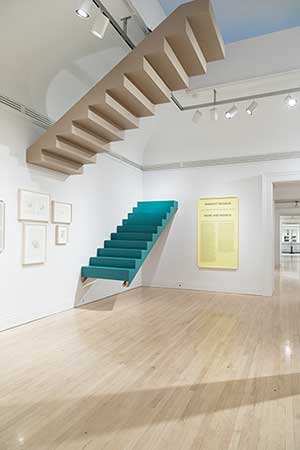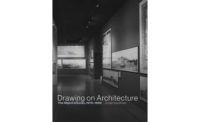“Postmodernism” in architecture is regaining our attention. Already in 2016, James Stirling’s No. 1 Poultry complex in the City of London (designed in 1985, but not constructed until 1997) was listed by the British Government, the most recent building to receive such recognition. Last year, a proposal by the Oslo and New York firm, Snøhetta, to renovate the portico of Philip Johnson’s 1984 AT&T (now known as 550 Madison) building in New York triggered its listing by the city’s Landmarks Preservation Commission.
History courses covering postmodernism are appearing on the curricula of many architecture schools. Then, last November, the Canadian Centre for Architecture in Montreal opened a major exhibition curated by Sylvia Lavin, professor of the history and theory of architecture at Princeton University, which closes April 7.
The exhibition has two strengths: for one, it is very large–comprising the largest number of artifacts (over 400) ever mounted by the CCA; second, it displays Lavin’s formidable ability to locate and to borrow artifacts from a vast number of specialized institutions and private collections. But the show is also problematic, starting with the title itself, which hovers ambiguously between two familiar characterizations of “postmodernism.” The first is a very broad one–associated with the French philosopher Jean-Francois Lyotard, and his famous 1979 book, The Postmodern Condition, and with the American cultural theorist Fredric Jameson, and his also significant publication of 1991, Postmodernism, or, the Cultural Logic of Late Capitalism. Both consider “post-modernism” to be an international political and cultural phenomenon, spanning many different disciplines and social practices. For Lyotard, this meant, above all, the end of the sort of “master-narrative” associated with the idea of “progress” going back to the Enlightenment. For Jameson, the “cultural logic” entails developments such as the gradual erasure of the difference between high and popular culture.
At the other extreme to these two thinkers, a much narrower characterization focusing primarily on architecture in the Anglo-American world was promoted in Charles Jencks’ controversial 1978 book, The Language of Post-Modern Architecture.
Lavin’s title leans to the narrower, Jencksian reading, but her selection of artifacts and her identification of themes are much broader, encompassing such developments as a revived architectural research interest in history, the establishment of new museums, and the rediscovery of the body, among others. To be sure, these themes are not orthodox modernist ones, but I do not think it is historically illuminating to label them “postmodern.” To me, the period preceding postmodernism from the early 1960s to the late 1970s–through which I lived–was characterized by a radically “revisionist” modernism.
It is indicative of the problem created by Lavin’s overly broad frame of reference, that among the artifacts displayed are preparatory materials of Kenneth Frampton for his revelatory early 1960s documentation of the 1930 Maison de Verre in Paris, designed by Pierre Chareau and Bernard Bijvoet. Stretching postmodernism back to the 1960s serves no purpose that I can see, and it ignores the fact that Frampton, professor of architecture at Columbia University’s Graduate School of Architecture, Planning and Preservation, has consistently been one of postmodernism’s harshest critics! For that matter, one would never know from Lavin’s curating here of architect Peter Eisenman, that he was the author of the disparaging acronym “Po-Mo,” to describe the tendency within which she subsumes his work, or that he has always insisted that architecture has to be “critical”, rather than acquiescent to current social practices.

Photo by Sandra Larochelle
Conversely, Lavin does not include much work that I would call “high” postmodern. There is, for example, nothing by Philip Johnson or Robert A. M. Stern, and even the work included of Charles Moore – his 1962 house for himself at Orinda, California and the 1966 Sea Ranch also in California, executed with his colleagues in the firm Moore, Lyndon, Turnbull, Whitaker, are projects of his that I would call transitional, rather than high postmodern. The latter characterization applies better to his 1978 Piazza d’Italia in New Orleans. So while the show is too broad in its outer framing, it is also a little empty at its core.
In addition to such unexplained American exclusions, there is also a major European one. The term “architecture itself” refers to the so-called “autonomy of architecture” introduced to international architectural discourse in the late 1960s by such European figures as Aldo Rossi and Giorgio Grassi. Grassi is not in the show at all, and Rossi is represented only by a “copy” of his famous drawing of the project for the Modena Cemetery. Lavin might have made a case for a primarily Anglo-American show, but then it makes little sense to include the term “architecture itself” in its title. Perhaps most inexplicably, she also makes no mention of what was surely the most important trans-Atlantic postmodernist event: Paolo Portoghesi’s 1980 Venice Biennale, which brought together major figures from both Europe and the USA.
In short, I was unable to deduce any clear criteria for inclusion or exclusion.
Finally, the show’s high level overview results in certain important historical details being missed. I think of the key role in this period of the young European architect Leon Krier, who is incidentally present in the show, but two of whose major influential activities are not. From 1968 to 1971, Krier worked for James Stirling, and Stirling’s practice subsequently shifted dramatically towards the postmodern. Then, in 1977, Krier co-taught a studio with Michael Graves at Princeton, and subsequent to that, Graves’ oeuvre also became much more figural.
All in all then, while it presents an wide array of interesting artifacts, the show does not offer a very refined historical understanding of the shift in architectural thinking that triggered its creation. By the way, Aldo Rossi did not think that the autonomy of architecture was a “myth”. Instead, he thought architecture should transcend contemporary reality – even be critical of it. And as far as I can tell, Peter Eisenman still agrees with him. As I argued in my 2004 essay: “Criticality and Its Discontents,” so do I.
The exhibition Architecture Itself and Other Postmodernist Myths runs through April 7, 2019, at the Canadian Centre for Architecture in Montreal.






Post a comment to this article
Report Abusive Comment